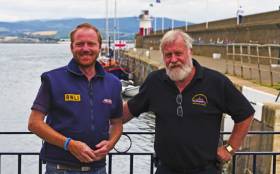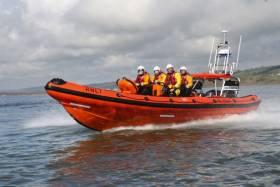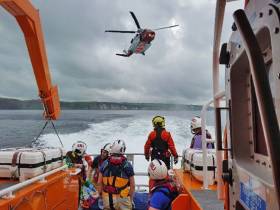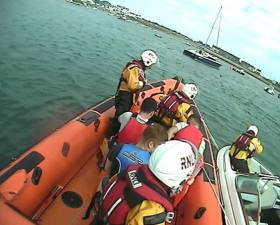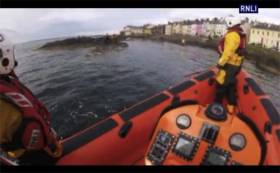Displaying items by tag: Lifeboats
Skerries Lifeboat Launches To Boat With Fouled Propeller
#RNLI - Skerries RNLI volunteers launched their Atlantic 85 inshore lifeboat on Thursday evening (28 July) to reports of a 21ft boat with a fouled propeller south of Rush Harbour.
A person on board the stricken vessel had contacted one of the volunteer crew and informed them that they had fouled their propeller and were anchored south of the harbour.
The crew were paged shortly after 8.30pm, and the lifeboat was quickly launched with Joe May as Helm and crewed by Rob Morgan, Peter Kennedy and Simon Shiels.
As the lifeboat was en route, the crew received an update to say that the casualty vessel had managed free their propeller and return safely to Rogerstown Estuary. The lifeboat was stood down and returned to station.
Speaking after the callout, Skerries RNLI lifeboat press officer Gerry Canning said: "Things can go wrong at sea, even for the most experienced seafarers. That’s why it is important to always have the correct equipment on board.
"In this case a good anchor gave [the casualty vessel and its crew] the time they needed to get themselves out of trouble."
The callout was the third in a week for the Skerries inshore lifeboat, after it launched to reports of swimmers in difficulty last Saturday 23 July, and rescued four from a speedboat grounded on rocks at Colt Island the previous Thursday (21 July).
#RNLI - Two members of Wicklow Lifeboat Station have received awards from the RNLI in recognition of their dedication and service over the years.
Deputy second coxswain Dave O’Leary has been awarded the crewman’s Long Service Badge for meritorious service to the RNLI.
O'Leary joined the volunteer crew in May 1996 and was appointed an inshore lifeboat helm in 2002. He was put on the coxswains plan in 2007 and became a deputy second coxswain in 2008, the year his sister Lisa became third mechanic.
In 2010, he took over and overhauled the inshore lifeboat crew training plan, and he is now an integral part of the station personnel.
Meanwhile, lifeboat operations manager Des Davitt was awarded inscribed binoculars for his service to the RNLI.
Davitt joined the RNLI Wicklow committee in 1993, becoming vice chairman in 1995 and taking charge of all fundraising for the branch with support from the Ladies Guild.
Davitt was chairman of the appeal committee who raised funds for the provision of a new inshore lifeboat and an extension to the boathouse to house the new lifeboat in 1996.
In 2001, he was awarded the bronze badge for his services to fundraising. Three years later, he took over the new position of lifeboat operations manager – formerly honorary secretary – from the retiring Kevin Desmond.
Fundraising then became separate from operations and Phylis Whyte took over the running of all fundraising activities.
As lifeboat operations manager, Davitt is responsible for all operational activities at the station and authorises the launch of the boat when a launch request is received from the Irish Coast Guard.
Youghal Lifeboat Launches Twice In One Day To Reports Of Engine Trouble, Missing Person
#RNLI - Youghal RNLI in East Cork was requested to launch twice this past Sunday (24 July) to separate reports of a boat with engine trouble and a missing person.
The volunteer lifeboat crew were first called upon to launch their Atlantic 85 inshore lifeboat at 12.40pm following a report that a small inflatable boat with two people onboard had appeared to have engine trouble somewhere between Youghal Lighthouse and East Point in Youghal Bay.
Weather conditions at the time were described as good, with a south westerly gentle wind blowing and a slight swell.
Once on scene, the lifeboat crew observed that the boat had made its way to shore near Moll Goggin's Corner. The two men with it were safe and well and happy to recover the boat themselves.
Speaking following the callout, Youghal RNLI helm Jason Ansbro said: "A member of the public on Lighthouse Hill did the right thing this afternoon and raised the alarm when they felt someone was in difficulty.
"Both men onboard were sensible and wearing lifejackets at the time."
The second callout of the day came at 10.45pm, when the lifeboat was requested to join in a search for a person reported missing in the water on the Waterford side of Youghal Bridge.
Youghal Coast Guard Unit and the Irish Coast Guard helicopter Rescue 117 from Waterford were also involved. But local Garda soon informed the rescue services that they were happy that nobody was missing and asked all agencies to stand down.
Cave Faller Rescue Caps Off Busy Week For Portrush Lifeboats & North Coast Lifeguards
#RNLI - It was another busy day for North Coast lifeboat volunteer crews as both Portrush RNLI lifeboats were launched for the second time in 24 hours yesterday evening (Sunday 24 July).
The all-weather and inshore lifeboats were launched at 5.30pm to reports of a casualty who had fallen onto rocks inside a cave just underneath Dunluce Castle.
Weather conditions were good with a calm sea and little wind which helped the lifeboats to reach the scene in good time. Rescue 999, the helicopter from Prestwick, was also tasked to airlift the casualty to hospital.
The Portrush inshore lifeboat (ILB), carrying a paramedic from the NI Ambulance Service, had to get as close to the shoreline as possible to recover the casualty.
Meanwhile, the all-weather boat (ALB) was waiting alongside to transfer the casualty so that the helicopter could carry out an airlift from the bigger boat.
"This operation took skill and precision and is something that lifeboat and rescue helicopter crews practice on a regular basis," said Portrush RNLI lifeboat operations manager Robin Cardwell.
"This was a textbook callout carried out with absolute precision by all involved. We hope that the casualty makes a full recovery."
Less than 24 hours previously on Saturday evening (23 July) both lifeboats were called out to reports of swimmers who were missing off the coast between Castlerock and Downhill.
Within minutes both lifeboats were on scene along with RNLI beach lifeguards on their rescue water craft. The Irish Coast Guard's Sligo-based helicopter Rescue 118 was also tasked.
The waters between the two land points were thoroughly searched with no swimmers being found. The search was stood down around 9.15pm and described as a ‘false alarm with good intent’.
Two other joint operations on the North Coast occurred earlier in the week, the first to reports of two surfers believed missing at Benone Strand on Tuesday (19 July).
Portrush's inshore lifeboat was requested by the lifeguards to assist in the search, though thankfully the surfers turned up safe and well.
The second callout on the same day around 4pm was to reports of a lost child at White Rocks beach. The coastguard and lifeguards searched the beach while the inshore lifeboat patrolled the sea just off shore. The child was found safe and well by the lifeguards.
More recently, the lifeguards themselves sprang into action on Saturday afternoon at Benone to assist a child who had been stung by a weever fish.
As part of their training the lifeguards undertake a comprehensive first aid course which equips them to deal with most situations they may encounter on a busy beach in the summer.
RNLI volunteer lifeguard press officer Liam Mullan reminded beachgoers to "always try to visit a RNLI lifeguarded beach. Remember to keep an eye on the flags and swim between the red and yellow flags.
"If you get into difficulty raise your hand and call for help. If you see someone in difficulty dial 999 and ask for the coastguard."
Skerries Lifeboat Launches To Swimmer In Difficulty
#RNLI - Skerries RNLI volunteers launched their Atlantic 85 inshore lifeboat on Saturday afternoon (23 July) after Dublin Coast Guard received a call from a concerned member of public about a swimmer in difficulty.
The lifeboat launched shortly after 12.30pm with Philip Ferguson at helm and crewed by Emma Wilson, Steven Johnson and AJ Hughes, after a swimmer was reported having difficulty returning to shore at the swimming area known locally as The Captains.
Within minutes the lifeboat was on scene, but there was no sign of any swimmers in the area. Before a search could be started Dublin Coast Guard received a second call to confirm that the swimmer had made it ashore and was safe and well. The lifeboat was stood down and returned to station.
Speaking after the callout, Skerries RNLI lifeboat press officer Gerry Canning said: :The member of the public who called Dublin Coast Guard was genuinely concerned for the swimmer and was right to make the call.
"Thankfully in this case our assistance wasn’t required, but our volunteer crew are always ready to respond to anyone in difficulty at sea."
The callout came two days after the Skerries lifeboat rescued four men from a speedboat grounded on rocks at Colt Island, as previously reported on Afloat.ie.
Bangor Lifeboat Rescues Two After Motorboat Breakdown
#RNLI - At 7:30am yesterday morning (Saturday 23 July), Bangor RNLI was requested by HM Coastguard to attend a boat off Carrickfergus in Belfast Lough, following the firing of a red distress flare.
On arrival at the scene, the volunteer crew were able to confirm that the boat, with two men on board, had fired the flare.
The men had left Carrickfergus early yesterday evening in calm conditions, but then suffered the loss of their main engine, followed by the failure of the auxiliary outboard.
After several hours trying to fix the problem without success, and with no working mobile phone or radio, they decided to wait until morning to fire a flare to attract attention.
The crew quickly rigged up a line between the stricken vessel and the Bangor lifeboat Jessie Hillyard, and towed them to Carrickfergus Marina. Just outside the marina they tied the motorboat alongside for better manoeuvrability in the close confines of the marina.
Bangor RNLI helm Gareth Whan said: “The crew and I are happy to have brought these men to safety, after what must have been a fairly miserable night for them on board a boat with no power in Belfast Lough.
“Incidents like this highlight the importance of ensuring your engines are in good working order, and the need to have a reliable way of calling for help if things go wrong.
"Luckily for them, the weather stayed good overnight, and the flare was spotted this morning.”
Previously the Bangor lifeboat was called out to rescue boys trapped on rocks while fishing last weekend, as reported on Afloat.ie.
Skerries Lifeboat Rescues Four From Speedboat On Rocks
#RNLI - Skerries RNLI launched yesterday afternoon (Thursday 21 July) after Dublin Coast Guard received a call from a vessel that had suffered engine failure near the islands off the North Co Dublin coastal town.
The lifeboat launched shortly after 4.30pm and proceeded to the general area indicated by the casualty vessel.
Arriving on scene, the volunteer crew spotted the speedboat, which had been pushed on to the rocks at Colt Island by the wind and tide. At the time there was a Force 3-4 south-westerly wind and a slight swell.
The lifeboat was carefully positioned to transfer a crew member to the casualty vessel. A tow was established and the boat, with four men on board, was towed clear of the rocks into safer water.
Upon inspection there did not appear to be any major damage to the hull so the tow was continued, returning them safely to Skerries Harbour.
Speaking after the callout, Skerries RNLI lifeboat press officer Gerry Canning said: "Thankfully the lifeboat reached them quickly as the situation was deteriorating quite quickly.
"However, all four were wearing lifejackets and crucially they were able to contact the shore for help."
Bangor Lifeboat Rescues Boys Trapped On Rocks
#RNLI - It was just a routine exercise for Bangor RNLI's volunteer lifeboat crew on Sunday night (17 July) until they got the call to rescue two young boys who were cut off by a rising tide while fishing at The Long Hole on Belfast Lough.
With assistance from HM Coastguard, the lifeboat was able to rescue the boys and return them safely to Bangor Marina.
Bangor RNLI volunteer lifeboat press officer Peter Semple said: "The crew and I were delighted to be able to put their training to use, particularly in such a rocky part of the coast.
"Although the boys were in no immediate danger, and their only concern after we got them back to dry land was that they got their fishing rods back, it is important for parents to explain the risks of being caught by a rising tide."
Bangor's lifeboat crew on this callout were helm Peter Semple with Dave Beale, Kat Lindsay and Alison Stobie.
#RNLI - Red Bay RNLI was paged at 6am this morning (Wednesday 20 July) to go to the aid of a 40ft yacht, with two people on board, after the vessel suffered engine failure and was unable to move.
The sailors were on passage from Scotland to Isle of Man when they got into difficulty some three miles east of Red Bay in Co Antrim.
With dense fog in the area, Belfast Coastguard requested the launch of the Red Bay all-weather lifeboat to tow the vessel to safety – and all safely arrived into Cushendall by 8.30am.
Wicklow Lifeboats Launch To Capsized Laser Off Greystones
#RNLI - Both Wicklow RNLI lifeboats launched on Monday afternoon (Monday 18 July) after the Irish Coast Guard received a report of a capsized boat drifting off Greystones.
The inshore lifeboat was first on scene and located the upturned Laser yacht, drifting south of Greystones Harbour.
The crew began an immediate search of the area in case there might be casualties in the water.
Weather conditions in the area were described as wind direction south Force 4 with a moderate sea state, and visibility was good.
During the search by both lifeboats, a call was received from the coastguard to say two people had been taken from the capsized boat by a sailing club tender and were landed safely at Greystones.
The tender then made its way back out to recover the overturned yacht. The inshore lifeboat crew assisted with righting the capsized boat and escorted the tender and the Laser yacht into Greystones before returning to Wicklow.



























